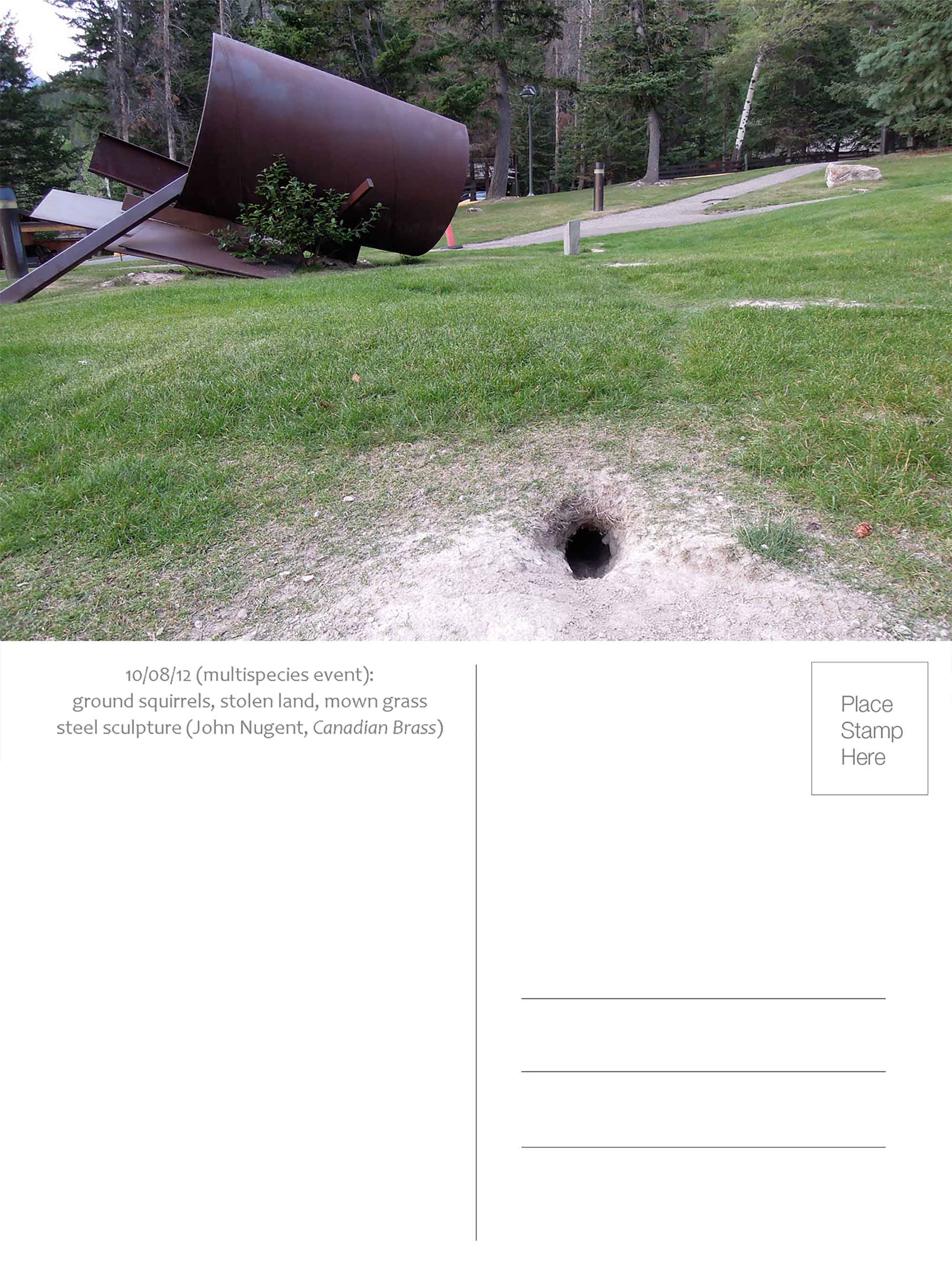
‘The possibilities of language are not only human and not only language’.
Stephen David Ross, ‘The Writing of the Birds, in My Language’, in Animal Philosophy: Ethics and Identity, ed. Matthew Calarco and Peter Atterton (London: Continuum, 2004), p. 190
10/08/12 (multispecies event) was produced through a practice of daily walks during The Retreat/dOCUMENTA (13) residency held in Banff, Canada in 2012. Through the walks, my intention was to observe and document traces of intersections between human and other-than-human worlds. Curious about animal agencies for shaping built environments, I used writing, drawing and photography to study the often unforeseen sensory, material and inscriptive forces by which urban habitats are produced.
The temporal and material dynamics of 10/08/12 (multispecies event) included asymmetrical calls-and-responses between multiple networks: rodents enact diurnal excavations, grasses persistently root, saplings thrust sunward, and steel structures bear down with sleepless rust and modernist gravity. By considering the inscriptive traces of multispecies entanglements, my work aims to unsettle anthropocentric perspectives in the production of built environments. The work’s postcard form addresses the representational politics surrounding a popular Canadian tourist site located within a First Nations land-base and historical meeting place.
Joanne Bristol’s artistic practice, research and teaching engage with a range of analog and digital materials and methods to deepen art’s capacity to articulate relationships between nature, culture, the body, and language. She has presented performances, installations, text-based works and single-channel videos internationally, and has taught at a number of Canadian universities.
Using a performative writing practice, her recent research considers perspectives on the ways in which discourses of species are entangled with those of space. Situating this practice in relation to feminist architectural theory and critical animal studies, her work expands upon writing’s potential to animate a more-than-textual biopolitics. This research informed a SSHRC-funded doctoral thesis, completed at the Bartlett School of Architecture in 2016 (PhD by Architectural Design).
Her writing has recently been published in Public 50: The Retreat, eds. Sarah Blacker, Imre Szeman, and Heather Zwicker, (50) (2014), Poetic Biopolitics: Political and Ethical Practices in the Arts, eds. Peg Rawes, Timothy Mathews and Stephen Loo, (London: I. B. Tauris, 2015), and BlackFlash 36 (2) (2019). Through a desire to contribute to environmental well-being and decolonizing imperatives in the arts and humanities, she is currently addressing questions of species belonging within the Treaty 4 territory of the Canadian Prairies.
My practice draws upon Jane Rendell’s concept of site-writing to address human relations with other-than-human worlds. Site-writing’s emphasis on situatedness and embodiment offers a multifaceted framework through which to observe and note how different species occupy, use and produce space. Site-writing’s reflexivity allows me to speculate on the potentials, limits and performativities of writing, including inscriptions produced by other-than-human agents, as well as my own performative writing experiments.
Billy-Ray Belcourt, ‘Animal Bodies, Colonial Subjects: (Re)Locating Animality in Decolonial Thought’, Societies 5, (1) (2015): 1—11.
Donna J. Haraway, When Species Meet (Minneapolis, Minn.: University of Minnesota Press, 2008).
Jane Rendell, Site-Writing: The Architecture of Art Criticism,( London: I. B. Tauris, 2010).






































































